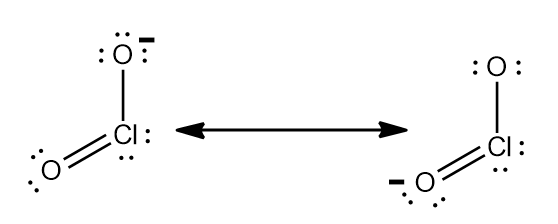
What is the charge on the polyatomic ions nitrite and chlorite?
Answer
430.8k+ views
Hint :We know that for solving this problem, you should have the knowledge about polyatomic ion and oxidation number.
A Polyatomic ion is an ion containing more than one atom. Oxidation number is the number of electrons lost or gained by an element during a reaction. Charges with respect to the Lewis structure, the charge on a polyatomic ion can be identified easily.
Complete Step By Step Answer:
Ions are those molecules or compounds that have either a positive or negative charge. They are classified as monatomic in which only one atom is present with either positive or negative charge, diatomic in which two atoms are present, and polyatomic in which more than two atoms are present. Lewis structure helps in representing valence electrons of a molecule. On calculating the formal.
Step-1: To calculate the charge on a polyatomic ion, the oxidation number of all the atoms can be added together.


Step-2: Nitrite ion stands for
Similarly Chlorite ion stands for
Step-3: The charge can also be calculated using Lewis structure and making sure every atom in the ion has
electrons. Using the given phenomenon and studying the Lewis structure of
Note :
There are many ways to identify the charge on a polyatomic ion and one can use any way they find easy to remember. But making the correct Lewis structure is an important step which must not be forgotten. The overall ionic formula of the compound must be electrically neutral, that is it should have zero charges and while writing the formula of the compound we assure that the cation part should come first followed by anion.
A Polyatomic ion is an ion containing more than one atom. Oxidation number is the number of electrons lost or gained by an element during a reaction. Charges with respect to the Lewis structure, the charge on a polyatomic ion can be identified easily.
Complete Step By Step Answer:
Ions are those molecules or compounds that have either a positive or negative charge. They are classified as monatomic in which only one atom is present with either positive or negative charge, diatomic in which two atoms are present, and polyatomic in which more than two atoms are present. Lewis structure helps in representing valence electrons of a molecule. On calculating the formal.
Step-1: To calculate the charge on a polyatomic ion, the oxidation number of all the atoms can be added together.


Step-2: Nitrite ion stands for
Similarly Chlorite ion stands for
Step-3: The charge can also be calculated using Lewis structure and making sure every atom in the ion has
electrons. Using the given phenomenon and studying the Lewis structure of
Note :
There are many ways to identify the charge on a polyatomic ion and one can use any way they find easy to remember. But making the correct Lewis structure is an important step which must not be forgotten. The overall ionic formula of the compound must be electrically neutral, that is it should have zero charges and while writing the formula of the compound we assure that the cation part should come first followed by anion.
Latest Vedantu courses for you
Grade 9 | CBSE | SCHOOL | English
Vedantu 9 CBSE Pro Course - (2025-26)
School Full course for CBSE students
₹37,300 per year
Recently Updated Pages
Master Class 9 General Knowledge: Engaging Questions & Answers for Success

Master Class 9 English: Engaging Questions & Answers for Success

Master Class 9 Science: Engaging Questions & Answers for Success

Master Class 9 Social Science: Engaging Questions & Answers for Success

Master Class 9 Maths: Engaging Questions & Answers for Success

Class 9 Question and Answer - Your Ultimate Solutions Guide

Trending doubts
Give 10 examples of unisexual and bisexual flowers

Draw a labelled sketch of the human eye class 12 physics CBSE

Differentiate between homogeneous and heterogeneous class 12 chemistry CBSE

Differentiate between insitu conservation and exsitu class 12 biology CBSE

What are the major means of transport Explain each class 12 social science CBSE

What is the difference between resemblance and sem class 12 social science CBSE




